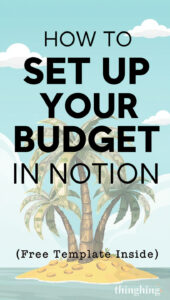Now Reading: How to Set Up Your Budget in Notion (Free Template Inside) 🔧💻💰
-
01
How to Set Up Your Budget in Notion (Free Template Inside) 🔧💻💰
How to Set Up Your Budget in Notion (Free Template Inside) 🔧💻💰
Get your money organized with zero overwhelm—even if spreadsheets make you want to cry.
If you’re tired of downloading budgeting apps that feel too complicated or boring, you’re not alone. I’ve been there—opening yet another budgeting app, trying to make it “my thing,” only to abandon it two weeks later because it just didn’t click.
But then I discovered Notion.
And let me tell you, budgeting in Notion feels less like a chore and more like a personal lifestyle dashboard. You’re in control of the design, the layout, the categories… basically, it’s budgeting with vibes. 💫
And the best part? It’s 100% FREE. Yes, really.
Here’s how to set up your very own Notion budget—without needing to be tech-savvy or obsessed with Excel.

✨ Step 1: Create a “Budget Hub” Page
Start with a clean, empty page in Notion. Give it a title like “Monthly Budget” or “Money Dashboard.”
Now add a cute emoji and cover image (trust me, it makes a difference). You want this to feel inviting—like a space you want to return to every few days.
💡 Pro tip: Add a short quote at the top like “Money flows to me easily and consistently” to keep the energy high.
📊 Step 2: Add Your Monthly Overview
Now, we’ll build your main tracker.
Insert a table database and title it “Monthly Budget Tracker.”
Here’s what your columns should look like:
-
Category (Groceries, Rent, Fun, Self-care, etc.)
-
Budgeted Amount
-
Actual Spent
-
Difference
-
Notes (optional but helpful!)
This simple layout helps you visually see where your money’s going and where you’re winning (or need to adjust).
You can color code rows by category or even add emojis 🌮🏠💅 to keep it fun and clear.
💡 Step 3: Personalize with Real-Life Categories
Here’s the magic: make this budget work for your life, not the other way around.
Don’t just stick with generic categories. Break it down based on how you actually spend:
-
Groceries vs Dining Out
-
Essentials vs Extras
-
Kids’ Activities, Pet Care, or even Holiday Sinking Funds
This is where Notion shines. You can easily duplicate rows, re-label things, and make it match the rhythm of your lifestyle.
🔁 Step 4: Add Monthly Rollovers or Reset Triggers
Sometimes you come in under budget (yay!), and sometimes… well, life happens.
Use linked databases or a second table where you can track how much you rolled over or overspent.
This gives you insight month-to-month and helps you reset when things go off track—without shame, guilt, or confusion.
🎯 Step 5: Set Goals Inside Your Dashboard
Budgeting isn’t just about tracking—it’s about dreaming.
Create a Goals section right on the same page. Include:
-
💸 Savings goals
-
💳 Debt payoff milestones
-
✨ Treat-yourself goals (yes, those are valid too!)
Make this area visual. Use progress bars, checkboxes, or even add inspirational photos of your dream vacation or that new couch you’re saving for.
It keeps budgeting emotionally rewarding—not just another “task.”
🌟 Why This Works So Well for Women Like Us
Notion gives you freedom to build a budget that reflects your lifestyle, your values, and your emotional triggers.
You’re not just logging numbers—you’re understanding patterns, building awareness, and creating a financial space that feels safe, empowering, and actually enjoyable to visit.
And if you’re a visual thinker or creative soul? This system was made for you.
📥 Bonus: I’ve created a free Notion budget template you can duplicate in one click.
It includes all the layouts, trackers, and visuals I mentioned—plus it’s totally customizable for your unique life.
Stay tuned for how to use the template most effectively and ways to supercharge it for long-term success… ✨
we built your basic budget setup in Notion. But now comes the real magic: using it daily, tracking like a pro, and tweaking things to match your life—even when life feels a little chaotic.
Here’s how to take your Notion budget to the next level. 💪
📥 1. Duplicate the Free Template (Start Instantly!)
Let’s not reinvent the wheel, okay?
I’ve created a clean, feminine, and user-friendly Notion Budget Template that’s:
-
Minimal but beautiful ✨
-
Pre-loaded with categories (but easy to change)
-
Set up for monthly and yearly views
-
Includes goals, notes, rollover sections, and habit tracking
🔗 Just click [here] to duplicate it into your Notion.
(Replace [here] with the actual link when sharing.)
Trust me, once you open it, it feels like your money just got a cozy home.
✅ 2. Build a “Daily Money Check-In” Habit
Let’s be honest—budgets only work if you use them. So here’s the best way to stay on track:
🌤 Each morning or night, open your Notion dashboard (on phone or laptop) and:
-
Log any spending from the last 24 hours
-
Check how close you are to your goals
-
Reflect briefly in the “Notes” column (even just “Went overboard on takeout 😅” helps build awareness)
⏰ This takes less than 5 minutes and gives you so much control.
💗 Make it part of your self-care routine—like journaling, but for your money.
📆 3. Create a New Page for Each Month (With 1-Click!)
Budgeting in Notion is so smooth once you learn to duplicate pages.
At the end of each month:
-
Duplicate your current “Monthly Budget” page
-
Rename it for the next month (e.g., August 2025)
-
Clear out the old numbers
-
Roll over anything left (like leftover grocery budget or saved amounts)
📂 You’ll end up with a beautiful archive of your financial progress month by month. So satisfying. 🥹
🔁 4. Automate Your Totals with Simple Formulas
This isn’t Excel, so don’t worry—Notion makes this part painless.
Inside your table:
-
Add a new property and select “Formula”
-
Use it to calculate total spent, total budgeted, or the difference
-
Example:
prop("Budgeted Amount") - prop("Actual Spent")
This way, the math handles itself, and you can just focus on the numbers that matter.
🧠 Pro tip: You can even sort categories by how much you’re overspending, so you know where to trim next month.
🎯 5. Turn Your Goals into Reality with Progress Bars
Visual motivation = financial motivation.
Use a progress bar formula in Notion to track savings goals like:
-
Emergency fund
-
Holiday shopping
-
Credit card payoff
Example formula:
😍 Every time you move the bar forward, you feel accomplished—and that feeling is what keeps you consistent.
💖 6. Make It Yours
Want your dashboard to feel like a Pinterest board meets financial tracker? Go for it!
Ideas:
-
Add images of your dream home, car, or vacation
-
Create a “Money Affirmations” toggle list
-
Add a quote block like: “Every dollar I save is a vote for the future I want.”
The more emotionally connected you are to your budget, the more likely you’ll stick to it.
Notion gives you the space to make it feel like a personal vision board, not just a cold spreadsheet.
🌸 Final Thoughts: Notion Budgeting is a Self-Love Practice
This isn’t just about numbers. It’s about giving yourself a system that works for you, supports your goals, and makes managing money feel less scary and more empowering.
Whether you’re:
-
Paying off debt
-
Saving for a wedding
-
Building freedom from paycheck-to-paycheck stress
Your Notion budget can hold space for all of that—with style and grace. 💕














